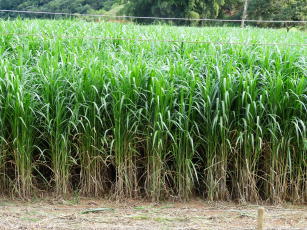Chemical weed control on establishment and post-cut of elephantgrass
Chemical weed control on establishment and post-cut of elephantgrass

Photo: Ledo, Francisco
Productivity and forage quality of elephantgrass (Pennisetum purpureum) are directly affected by weed interference. The difficulty of control of these species is one of the main barriers to production and use of the forage as feedstock, as well as to the production of biomass for energy use. Despite the great progress in agro-ecological weed control techniques, herbicides are still indispensable. Thus, the rational use practices of these products should be improved in order to produce quality food and with less impact to the environment and human health. The overall objective of this project was to develop weed management technologies in elephantgrass cultivations, in order to avoid productivity losses, ensure biomass production stability throughout the crop cycle and produce forage within legal pesticide residue limits. The different periods of weed-elephantgrass competition were identified, helping determine the stage of this forage crop cycle in which control practices must be effectively adopted, prevent the interference in the initial phase of crop growing, and indicate herbicides selective for elephantgrass and application doses effective in controlling weeds without negative effects on yield, within the herbicide residue limits allowed by the regulations. Finally, technology transfer initiatives were conducted in order to stimulate the adoption of the recommend practices by farmers. From an economic point of view, the actions are helping to reduce elephantgrass productivity losses, ensuring greater income to farmers. Environmentally, there is a lesser risk of contamination of soils, watercourses and animal feeds due to the rational use of herbicides and doses required to control weeds in elephantgrass pasture areas.
Ecosystem: Amazonic, Coastal Areas, Campinaranas, Extreme South, Atlantic Forest, Semi-mixed and seasonal forests, Mid-North, Pantanal, Caatinga Region and Mixed forests, Cerrados Region, Pinheirais Region, Ecological Transition
Status: Completed Start date: Fri Aug 01 00:00:00 GMT-03:00 2014 Conclusion date: Sun Jul 31 00:00:00 GMT-03:00 2016
Head Unit: Embrapa Dairy Cattle
Project leader: Alexandre Magno Brighenti dos Santos
Contact: alexandre.brighenti@embrapa.br
Keywords: herbicidas, forrageiras, invasoras
